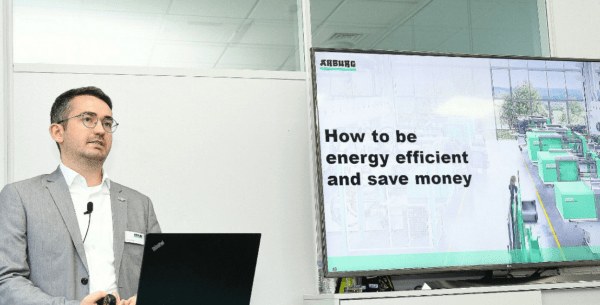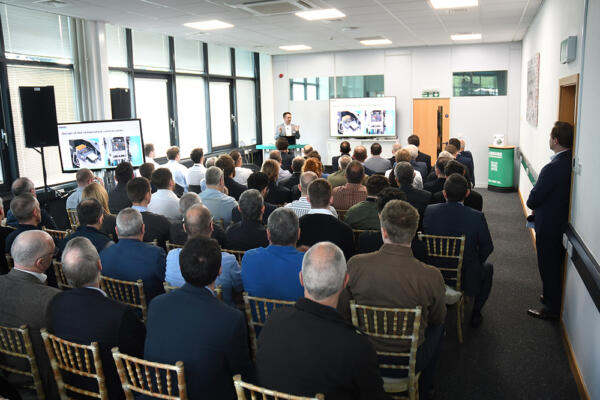Want to know how to save hundreds of pounds in energy by simply optimising your machine and processes? There are eight steps to running the most energy-efficient moulding machines, as Lukas Krueger, Applications and Industries Manager at ARBURG, explained to guests at ARBURG’s Open House to celebrate 100 years of the Hehl company on 17 May.
How to be energy efficient and save money
- Product design
- Mould technology
- Machine technology
- Peripheral technology
- Configuration
- Process integration
- Process control, and
- Production planning
Firstly, choose the right material, maintain tolerances suitable for plastics, and look to reduce wall thickness and material quantity. Then, energy can be saved by insulating the mould and clamping platens, tubes and even hot runners if these are used. You can adjust the tube sizes and measure the energy consumption to find the most efficient tube size. Next, cooling in the mould can be modified to use water more effectively. An efficient design and close contours can reduce cooling time, cutting energy in the water pump. Machine technology is the biggest single factor in reducing energy. Hybrid and all-electric machines are the most energy efficient, closely followed by energy-optimised hydraulic machines. Regular hydraulics, while robust and capable machines, can use twice the electricity of a modern electric machine. Insulate the cylinder heating zones, using full cylinder insulation if possible. When designing cylinder insulation, consider the optimum temperature regulation for your moulding process. ARBURG has run energy usage tests of fully insulated versus non-insulated cylinders and moulds for different size machines. Energy savings depend on the electricity rate and machine size, varying from £240 to up to £2,280 for an ARBURG 820 S 4000 at 40p / kWh. Using peripherals, the design and choice of temperature control units can also affect total energy usage. The configuration of the machine for different purposes and volumes will consume energy very differently. It depends on the machine technology; hydraulic, servo-hydraulic or electric. High-volume packaging typically requires a lot of energy due to the constant closing/injecting/opening, whereas low-volume parts usually need more cooling time, during which, with a servo-hydraulic machine, almost no energy is consumed (the pump idles during holding pressure). So, for packaging, an electric versus servo-hydraulic machine will register much higher energy-saving, but this difference is smaller for low-volume work. The relative energy gain per cycle (or energy saving per part) is higher on slow-cycling parts. The energy gain per individual part is lower on fast cycling parts, but many more parts are produced per hour/day, so the absolute energy gain over time is higher. For process integration, automating operations can also reduce some energy used. Automation increases the machine’s productivity by having consistent operations on de-moulding or other secondary activities. This leads to reduced cycle times and reduces the overall time required for the machine to be used, cutting energy, albeit in small amounts.
Optimum process settings are the key to cutting electricity
Although it may sound obvious, programming the optimum settings on the machine controller can reduce energy costs, sometimes very significantly. These settings include the mould locking force, dosing time, injection speed, mould temperatures, and cylinder and runner temperatures. Here, arburgXworld Control FillAssist can help the user reduce rejected parts and create more stable production conditions (temperature, pressure, injection speed) that together produce the most efficient shot for the application. These settings are crucial – contact ARBURG to find ways to help you select the most energy-efficient settings that don’t affect performance. Beyond the machine, peripherals and process settings, planning your production properly, and considering energy management can also save you money. Typically, a commercial energy contract specifies in advance how much energy you need and what you’ll pay for. Exceeding the band can incur a higher kWh rate, so it is important to know your maximum peak load. The user can have an excess or higher capacity supply in place, but this facility will cost more even if it is not used. “It really pays to switch on all your machines in a sequence and having energy management on each machine to spread the electricity load over time,” says ARBURG Ltd. Sales Director Nicolas Stein. Automatic and staggered switch-on: ARBURG’s software calculates the best moment during a start-up process each component is switched on, so everything reaches peak performance at the same time, just before starting production. Switching on all components together creates high peak loads, and components can be heated up and ready to go while other areas need several more minutes to reach optimum temperature. One very common problem for energy loss in plants is compressed air leaks. At 12 bar pressure, a 10mm diameter hole in the system can lose the company £640,000 a year at 40p p/kWh. Leak testing and repairing your air source will reduce energy bills. The message is to check every stage of the entire process chain for sub-optimal set-ups and amend them where possible.
Switching to electric can save thousands
ARBURG has extensively tested several different machines with energy-optimised technology against a baseline hydraulic machine. Tests compared a 470S (non-servo) hydraulic, 470H hybrid and 470A ALLDRIVE all-electric machine. Comparing the 470S hydraulic, the ALLDRIVE “Comfort” saved 40,200 kWh per year, based on extrapolated reading energy readings. At the cost of 40p p/kWh this equated to £16,800 savings per machine in a year. A 10-machine shop, with identical machines, could therefore save over £160,000 in a year. Such huge savings would normally only apply when an older hydraulic machine is replaced by a new modular electric machine such as an Alldrive/Golden Electric. ARBURG has made sustainable manufacturing a pillar of the business in the last five years and has a wide range of machinery and software solutions to reduce carbon emissions, mainly covered under the arburgGREENworld suite of technologies. We also now have ARBURG Action Plan Energy, a programme that provides energy advice, usage measurement, retrofitting efficient parts, training and more. For more advice on energy savings, email energy@arburg.com. For more details about the expert presentations delivered at ARBURG’s open-house event in May, click here.
Read more news from ARBURG here.



